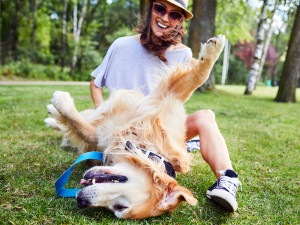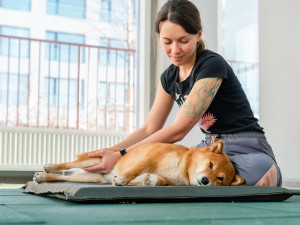7 Ways to Give Your Dog a Break
Because pups need to switch off too
Just like humans, dogs need time to unwind, relax and recharge. While training, playtime and outside adventures are important parts of your dog’s life, dog downtime is just as important for their overall well-being. Without proper rest, your dog can become overstimulated and stressed, especially if they’re a young puppy or an anxious dog. Let’s explore some simple and effective dog relaxation techniques to help your dog find a sense of calm amid the busyness of life.
Why dogs need downtime
Quality regular downtime is vital for dogs to rest and manage stress. We often think we need to be doing more with our dogs, not less. But without adequate dog downtime, their mental and physical health can suffer.
Common dog stress signals include panting, lip licking, yawning when not tired, a tucked body posture or becoming unusually clingy. These signs can go unnoticed until they escalate into a bigger behavioural challenge, such as problematic barking, repetitive pacing or reactivity to people or dogs. Understanding and recognising your dog’s body language cues is key to providing early dog stress relief.
A 2020 studyopens in new tab found that “72.5 percent of dogs had some kind of highly problematic behaviour”. According to the PDSA Animal Wellbeing (PAW) Report 2024opens in new tab, approximately 18 percent of dogs show signs of separation anxiety. The PDSA also found that “a large proportion of dogs are likely to not be getting enough sleep, with 27 percent (2.9 million) sleeping for 10 hours or less in a day, and 53 percent (5.6 million) of dogs getting under 13 hours sleep.” This goes against the agreed average of 12–16 hours that dogs should enjoy.
We know what it’s like to need some quiet time after a hectic work day, busy family time or the stresses of daily life. While we can choose how to take that downtime – to unwind – our dogs don’t have that option. Instead we can provide enrichment, sniffing opportunities, routines and quiet times of day to help improve our dogs’ stress levels.
Signs your dog is overstimulated
Being able to recognise the signs of overstimulation is key to ensuring your dog’s well-being. Whether it’s from too much excitement, unfamiliar environments or an overload of triggering experiences, an overstimulated dog may exhibit both behavioural and physical stress signs, including:
Excessive panting. Even when it’s not hot or after exercise, rapid panting can indicate stress or sensory overload. Panting can also indicate pain, which is why it’s important to work with your vet when you see this.
Pacing or restlessness. A dog that can’t settle, walks in circles or constantly moves may be overstimulated or physically uncomfortable. Moving their body might be a compulsive, repetitive behaviour or it can indicate a dog that is trying to raise their adrenaline levels to combat pain.
Whining or barking. Increased or unusual vocalisations, especially if persistent, are clear dog stress signs. Barking can help to release emotion and provide a temporary sense of relief.
Avoidance behaviours. Turning away, hiding or refusing to engage might be a sign that your dog is shutting down emotionally to escape stimulation.
Wide eyes, lip licking, pinned back ears. These physical body language cues are just a few of the common signs that often accompany an overstimulated dog.
Exaggerated startle responses. Overreacting to noises or movements can be a sign that your dog is experiencing sensory overload. A stressed dog will become hypervigilant, where even the smallest of triggering events can cause them distress.
Refusing food. If your dog usually eats their food well, sudden refusal can be a sign that something is wrong physically or emotionally.
If your dog shows any of these symptoms regularly, or if signs worsen, consult your vet as well as an ethical behaviourist. A vet can rule out underlying medical issues to ensure there’s nothing physical going on.
7 proven ways to give your dog a mental break
To help reduce dog stress, we can implement some simple strategies to support them in getting quality downtime.
1. Create a quiet sanctuary space
Establishing a dog quiet space is essential for helping your dog decompress and feel secure during downtime. While some dogs might struggle to begin with, separating themselves from you to enjoy this calm sanctuary – over time they will hopefully see the value in quiet time spent there.
Choose a low-traffic area of your home, such as a quiet corner of the living room or a spare bedroom. Setup a sleeping area there for your dog – or even better, a choice of sleeping options such as a crate, a floor bed and a raised bed. To keep the space feeling protected from the outside world, cover the lower parts of windows with temporary frosting, to block visual stimuli, and play white noise or calming music to create a sound buffer to external noises.
Add things your dog loves, such as their favourite toy, a water bowl, or maybe even an item of your clothing to add your supportive scent into the space. You can even get warming pads or a Snuggle Puppyopens in new tab with a heartbeat simulator to add in some extra comfort if you have a young puppy.
By creating a designated dog safe space, you’re giving them a trusted refuge to retreat to whenever they need a break from stimulation – crucial for their emotional well-being and overall behaviour.
2. Practice canine meditation and breathing
Introducing your dog to dog meditation and breathing techniques – similar to those that benefit humans – can help them become more centered and relaxed, especially when in high-stress environments.
While you can’t teach your dog to repeat helpful mantras or practise paced breathing, teaching your dog to sniff on cue or facilitate sniffing at a time when they’re more aroused, can help to reduce their stress levels. Sniffing is in essence a dog’s own ‘mindful breathing’ as they don’t breathe in the same way when they’re sniffing as they usually would. These sort of calm dog techniques can be a really helpful part of changing how your dog feels when they’re out in the world.
Changing your own breathing – thus reducing your stress levels – can help support your dog’s emotional well-being. Sit close to your dog and focus on your own breathing: breathe in to the count of four through your nose, hold your breath for four seconds, then breathe out to the count of four through your mouth, before holding your breath again for four seconds. Repeat this for two to three minutes. Dogs feed off our own energy and so by focusing on your own breath, you can in turn encourage your dog to relax as well.
3. Implement structured rest periods
Just as we might put young children down for regular naps or create peaceful times of the day with less stimuli, so it can be important to create a dog rest schedule that works for your individual dog. Especially when your dog is a puppy or adolescent, they might find it difficult to self regulate and make the decision themselves to sleep or rest. That’s where a solid dog routine can come in handy.
For example, with a puppy where the average rest requirements are higher than for adult dogs, you might have a nap schedule that follows this sort of routine:
7am – wake for the day, toilet and breakfast
7.30am – five minutes of training and a short playtime
8am – cuddles
8.30am – nap
11am – wake, toilet
11.30am – short walk (15–20 mins)
12.30pm – lunch
1pm – nap
4pm – wake, toilet
4.30pm – short walk (15–20 mins)
5pm – dinner
6pm – nap
8pm – wake, toilet
8.30pm – five minutes of training and a short playtime
9pm – cuddles
9.30pm – final toilet
10pm – bedtime, overnight
Anxious dogs, youngsters, and senior dogs can all benefit from extra rest and downtime to help them feel the best they can – both physically and behaviourally.
4. Use calming scents and sounds
When your dog’s nose is their strongest way of collecting and processing information – it follows that their scent system can also be used to help support them when they’re feeling anxious or overwhelmed. Incorporating dog calming scents needs to be handled carefully, ensuring that your dog is able to choose between interacting with the smell or moving away.
Scents such as lavender or chamomile are known to help us humans relax – and the same can go for our dogs. You might use a product such as Pet Remedyopens in new tab sprays or plugins, or the pheromone collars and diffusers from Adaptilopens in new tab, which have been shown to create the same sense of calm for many dogs. Or there’s a process known as applied Zoopharmacognosyopens in new tab, which is where the dogs themselves get to self-select the scents they find more useful. You can look for a practitioner in your area to guide you through this process.
In addition to creating a different scent picture for your dog, dog relaxation music or white noise being played within your home can help increase the sanctuary feel. Various studies have shown that classical, soft rock and reggae are our dog’s preferred music genres. Popular playlists like Through a Dog’s Earopens in new tab or Relax My Dogopens in new tab are specially composed to reduce canine anxiety. There’s even a podcast for dogsopens in new tab to tune into, which uses soothing human voices to help dogs who struggle with alone time.
5. Gentle massage and touch therapy
If your dog is comfortable being handled, then incorporating dog massage techniques into your routine can be a powerful way to promote relaxation and bonding. Massage helps soothe sore muscles, improve circulation and might even reduce stress. Start with gentle, slow strokes along your dog’s back, moving from the neck down to the tail. Use light pressure and observe your dog’s body language to ensure they’re comfortable. Avoid touching the parts of your dog that are less enjoyed – usually their head and feet.
It’s important to avoid massage if your dog has a recent injury, inflammation or open wounds, or shows signs of pain when touched. Always consult your vet before starting a new therapy, they may also be able to help with a list of recommended local practitioners in your area.
6. Limit overwhelming activities
Dog overstimulation can occur in different contexts, depending on the individual dog. It could be that they struggle in a crowded dog park, at loud family gatherings or around busy traffic areas. These situations can lead to stress and anxiety, which may culminate in unwanted behaviours like barking, jumping or difficulty relaxing.
To support your dog’s well-being, it’s important to understand just how much your individual dog can take on and put in place some dog activity limits.
While there’s often a recommendation of limited walks for young puppies related to their physical development, it’s important to remember how much stimulus they’re also experiencing at a young age when out on walks. A reduction of exercise can have emotional benefits as well as physical.
For all dogs who get easily overwhelmed, think about creating more balance in their world. Combine short play sessions with calm sniffing. Reduce walk lengths or choose a calmer, quieter space to take your outside adventures. A rest day – an occasional day off from walks – can sometimes even provide an emotional reset. Introduce new experiences slowly and watch out for signs of stress in your dog.
7. Establish technology-free zones
In today’s connected and technology-rich homes, constant exposure to screens and electronic devices doesn't just affect humans – our dogs feel it, too. Dog screen time and the accompanying noise from TVs, tablets and phones can contribute to dog technology stress. While not all dogs respond to screens, those that do often find them overstimulating.
Electronic devices can impact dogs in several ways, mainly due to the high-frequency sounds and flickering lights they produce, which may lead to stress, anxiety or physical discomfort.
To help your dog decompress, consider establishing technology-free zones in your home. These spaces, where all tech is off-limit, allow your dog to relax in a quiet, calm environment.
Reducing your dog’s exposure to household electronics not only minimises stress but could give the added benefit of strengthening your bond through distraction-free interactions. A little ‘unplugged time’ goes a long way in supporting your dog’s mental well-being.
When to seek professional help
While some stress-related behaviours in dogs can be managed at home, through simple environmental, dietary or lifestyle changes, watch out for warning signs indicating it’s time to seek expert advice. If your dog exhibits persistent signs of anxiety – such as excessive barking, destructive behaviour or aggression – it’s important to consult a professional. Sudden changes in behaviour, especially without an obvious trigger, always warrant a visit to the vets as a starting point, followed by behavioural support.
For specialised dog anxiety help, seek out the help of a qualified, ethical dog behaviourist UK professional. Alongside your vet, a canine behaviourist will be able to assess emotional and behavioural issues, supporting you by creating tailored behaviour modification plans. In more complex cases, your vet may recommend working in tandem with a veterinary level behaviourist, especially if medication is needed to support your dog’s anxiety.
During an initial consultation, the behaviourist will typically take a full history of your dog’s environment, routines, diet and any triggers you’ve noticed. They may observe your dog’s behaviour in different settings before creating a structured plan to reduce anxiety and increase calm downtime. This usually consists of a complete well-being approach, including training exercises, environmental and lifestyle changes, alongside management and relaxation techniques.
Early intervention can significantly improve your dog’s well-being, so seek support early on.
The bottom line: how to give your dog downtime
Just like us, dogs need downtime to recharge their minds and bodies. Without enough rest, they can become overstimulated, anxious and develop problematic behaviours. Recognising signs of stress early – like panting, pacing or restlessness – can help prevent escalation. From creating a calm sanctuary and limiting sensory overload to introducing massage, calming scents and structured rest routines, there are many ways to support your dog’s emotional well-being. Prioritising relaxation time isn’t lazy – it’s essential. And if stress signs persist, don’t hesitate to consult a vet or qualified behaviourist for support.






